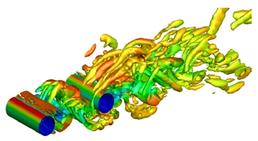Hybrid RANS/LES methods
- Started
- 3rd September 2007
- Ended
- 3rd September 2010
- Research Team
- Markus Weinmann
- Investigators
- Richard Sandberg
Improved numerical methods, physical modelling, and, most importantly, the recent advances in computing power have enabled CFD to become an essential design tool used complementary to experiments and theoretical methods for increasingly complex industrial applications. The current industry standard for simulating the flow around complex geometries is the application of Reynolds averaged Navier-Stokes (RANS) and unsteady RANS (URANS) calculations. However, RANS based models are not capable of accurately predicting lift and drag in cases where flow separation, laminar-turbulent transition and other complex flow phenomena occur. Only with a reliable and precise prediction of these flow features can industrial application be optimised for their intended use. An advanced flow simulation strategy that captures the relevant flow phenomena for an accurate prediction of lift and drag at moderate computational cost is therefore being developed. The new methodologies are being tested on a range of canonical flows, such as the NASA benchmark problem of a tandem cylinder.
Categories
Physical Systems and Engineering simulation: CFD
Algorithms and computational methods: Finite volume
Simulation software: OpenFOAM
Visualisation and data handling software: TecPlot
Programming languages and libraries: C++, MPI
Computational platforms: HECToR, Iridis, Lyceum
Transdisciplinary tags: HPC, Scientific Computing
